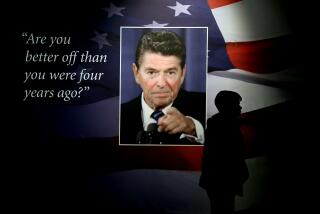Capitol Journal: 1976 Convention flashback: Why Donald Trump is no Ronald Reagan
- Share via
In Sacramento — Forty years ago, Republicans held a riveting, robust convention in Kansas City, where a rebel Californian nearly wrested the party’s nomination from a powerful sitting president.
Compared to this week’s horror tale in Cleveland, the Kansas City story was like a Frank Capra feel-good movie starring a popular but underestimated former so-called B-movie actor.
“I hated that expression,” says Stu Spencer, who was Ronald Reagan’s chief strategist for most of his winning election campaigns. In 1976, however, he was advising the other side: President Gerald R. Ford’s.
“Back then everyone was taking Reagan too lightly,” Spencer recalls. “I was running around the White House saying, ‘This guy is tough. He’s serious. He can really win.’ ”
The convention showed American politics at its best: Rough but respectful, cutthroat but civil.
No Donald Trump-like “Lyin’ Jerry” or “Corrupt Ron.”
“There was no anti-Ford animus in our meetings,” says Steve Merksamer, then a California delegate, later chief aide to Gov. George Deukmejian and since then a highly successful Sacramento-based political attorney.
“Jerry Ford was a good man, well-respected and well-qualified to be president. It’s just that Reagan was exciting and he energized people. Ford didn’t.”
Or, as I quoted California state Sen. H.L. Richardson at the convention for a Times story: “Reagan could get a standing ovation in a graveyard. Ford puts you to sleep by the third paragraph.”
Reagan and Ford had fought throughout the primaries. As the convention began, neither had enough delegates to clinch the nomination. But Ford led by an estimated 72, with 119 uncommitted.
The former two-term governor with the uplifting message flew to the convention committed to stopping the president.
Live convention coverage from Cleveland »
That was one huge difference between then and now and why the #NeverTrump movement has been doomed from the start. He may be highly unpopular, but Trump has no rival fighting to be the party’s alternative standard bearer.
“Trump has gotten this far because his opposition could never consolidate behind anyone,” says Robert Naylor, a California delegate in 1976, later the Republican leader of the state Assembly and now a veteran lobbyist.
“One thing Trump has proven is that philosophical purity is not necessary to get nominated. I don’t find him charismatic at all, but he does have the ability to excite a lot of people.”
Weak anti-Trump forces have banked on trying to repeal a convention rule that the Ford camp rammed through in ’76: a requirement that delegates, on the first ballot, be bound by the wishes of their states’ primary voters. No “conscience” voting.
Strangely, Reagan’s strategists didn’t aggressively contest that rule. Instead, they staked their insurgency on trying to force a candidate to name his running mate before the presidential nomination roll call.
They figured if Ford did that, he would make enemies of several vice presidential wannabes. And it might mitigate some of Reagan’s self-inflicted damage from having selected liberal Sen. Richard B. Schweiker of Pennsylvania as his veep three weeks earlier.
Reagan was desperately trying to attract moderate Rust Belt delegates. But the surprise move angered many southerners.
I had followed Reagan on a damage-control trip to Mississippi, where one delegate, asked about Schweiker, told me: “I am still chewing on him. I can’t get him down.”
In Kansas City, Californians were given daily assignments to lobby specific delegates from other states. The main organizer was Lyn Nofziger, an aggressive former chief political writer for Copley newspapers who had been Reagan’s first press secretary.
“Lyn instructed us how to conduct ourselves,” Naylor recalls. “One of our delegates asked him, ‘What should be our demeanor?’ Lyn answered, ‘The meaner the better.’ ”
In fact, one of my most vivid memories of that week was Nofziger grabbing a delegate from another state by the collar and shoving him into a tiny makeshift enclosure on the convention floor for a finger-jabbing, intimidating lecture.
But the president had unmatched powers of persuasion — White House dinners, rides on Air Force One and barrels of pork.
“A lot of people got flights, got hospitals in their districts, a few guys got pardons,” Spencer remembers, chuckling.
The California delegation was relegated to the back of the hall by Ford-directed convention planners. From there, they loudly cheered or booed, and stood on their seats, thumbs up or down depending on the situation. As the week progressed they became more disruptive and depressed.
Reagan narrowly lost the test vote on the vice presidential mandate. That led to Ford’s first ballot nomination by a relatively small margin of 117 votes. California cast all 167 of its votes for Reagan.
This week, all 172 California votes are in Trump’s column.
Before Kansas City, there hadn’t been a tightly contested Republican convention in 24 years, since Dwight D. Eisenhower beat Sen. Robert Taft in 1952. And there hasn’t been another one for either party since 1976.
Spencer thinks Reagan strategists blew it by choosing a procedural rule for the test vote. If they’d made it over a question of philosophy or just gone straight to the nominating vote, he says, “I don’t think we could have held our delegates. Many loved Reagan.”
The morning after the convention ended, Reagan thanked the California delegation. Reciting an English warrior’s ballad, he said: “I’ll lay me down and bleed awhile. Though I am wounded, I am not slain. I shall rise and fight again.”
There weren’t many dry eyes. And the triumphant 1980 campaign was launched.
Follow @LATimesSkelton on Twitter
ALSO:
California Republicans would be wise to cut Trump loose
Watch the conventions gavel-to-gavel
Join The Times for a convention watch party
More to Read
Get the L.A. Times Politics newsletter
Deeply reported insights into legislation, politics and policy from Sacramento, Washington and beyond. In your inbox three times per week.
You may occasionally receive promotional content from the Los Angeles Times.











